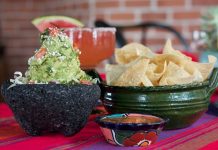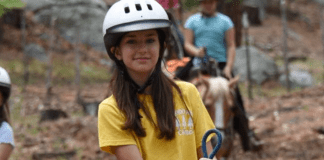Maybe you have heard of it via social media or perhaps a friend is into it, but baby led weaning is sweeping the baby scene. What is this magic, and can it help my child eat what I’m already preparing for me and the rest of my family?
Baby led weaning (or BLW) is infant self-feeding. It is teaching your baby from the get-go to feed themself, instead of exclusive parent-fed purees. They start eating foods that you, the adult, are also eating.
My husband and I took a class at Modern Milk in Scottsdale with Megan McNamee MPH, RDN (a Registered Dietitian Nutritionist). Megan co-owns a business called Feeding Littles with Judy Delaware, OTR/L (Occupational Therapist) who specializes in feeding therapy.
I’m going to give you some of the basics on how BLW is done, choking (which is a huge concern), choking hazards, allergens, what we fed our daughter first with BLW, and no no’s for babies and solid food.
Megan gives you so much information, not to mention there are a lot of great Instagram accounts with food ideas (one of my favorites is @blwideas), and books with lots of great information. Please seek out some professional information before starting BLW.
How – Food is given in a stick or strip shape, as babies at this age (around 6-months or when they can sit up unassisted) are typically unable to form the pincer grasp to pick up individual small pieces of food. BLW is messy! Don’t let that deter you. I have whipped up a little (not super pretty) fix with a $10 hard shell baby pool.
Choking – Yes, this is a concern. All babies will typically gag at first when starting solid foods, regardless of if you start those solid foods at 6 months or do purees first and start solids later. The key is to know the difference between gagging and choking, and be prepared for choking, should you need to help your child.
Choking hazards – Baby could choke on anything, but there are a number of foods that could completely block your baby’s airway. Babies are just learning how to chew, and these foods need to be either avoided or properly prepared. I hadn’t honestly considered what I shouldn’t feed my daughter when starting solid food.
- Hot dogs – Do not slice into rounds; cut in half or quarters lengthwise. Also, watch the salt content in hot dogs.
- Whole nuts – Avoid these until baby is closer to 4/5 years old. Nut butter are okay for babies, but thinly spread for newer eaters.
- Whole grapes – Quartered until baby is closer to 4/5 years old.
- Chips or crackers – I avoided these until our daughter got to be about 1.5 years. The sharp edges concerned me. She now has enough teeth and is experienced enough with chewing that she can handle them, though I do watch her closely.
- Raw fruit and veggies – We do the pinch test on fruit and veggies. If you can easily pinch a piece of fruit or veg between your pointer and thumb fingers and it smashes, it’s okay to give to baby. I cook anything else so it’s soft and I trying to give it in appropriate sizes. My daughter started with sticks of veggies and now she’s moved on to small bites, as she can pick them up or use a fork/spoon.
- Cheese – I slice this very thinly for her. Cheese sticks make me nervous because if she bites a larger piece off, she could get it stuck since it’s so firm/solid. Again, I watch her like a hawk with these things.
First foods for my daughter – We started our daughter with banana, sweet potato, avocado, chicken, applesauce on a NumNum GOOtensil, toast with thin spread of peanut butter.
Allergies – There is emerging research that allergens should be offered to babies between 6-12 months of age, to help reduce their chances of having an allergy to the particular food. While you can be allergic to anything, these are the top allergens:
- Peanuts
- Tree nuts
- Milk
- Wheat
- Soy
- Eggs
- Fish
- Shellfish
No no’s – No honey, no added sugar and no added salt
- Honey is a no-go for babies under a year old, as it contains spores that can cause infant botulism, which is rare but can be fatal.
- Added sugar doesn’t offer nutritive benefit for children. Consider using something like maple syrup to sweeten foods, if needed.
- Salt is not good for baby’s kidneys, which are too immature to process a lot of salt. For babies under 1 year of age, it is usually recommended to keep salt intake to about ¼ tsp. When I cook our food, I omit salt now, and my husband and I will add a little at the end to our individual food.
For the record, I’m not a doctor, nutritionist, feeding therapist or expert. I have educated myself on this method and have used BLW for my 21-month-old daughter. Please, if you are considering using this method or are interested in learning more, I highly recommend going to a class with Megan at Modern Milk, or taking her baby led weaning online class. There is so much information and I’ve only grazed the surface here, to give you a basic idea.
Do you do BLW? What caused you to pursue this method in your home?












